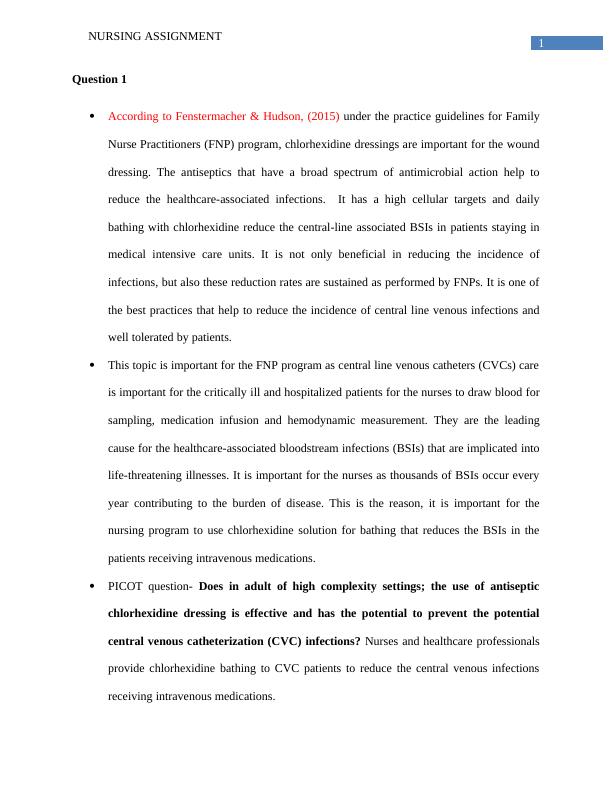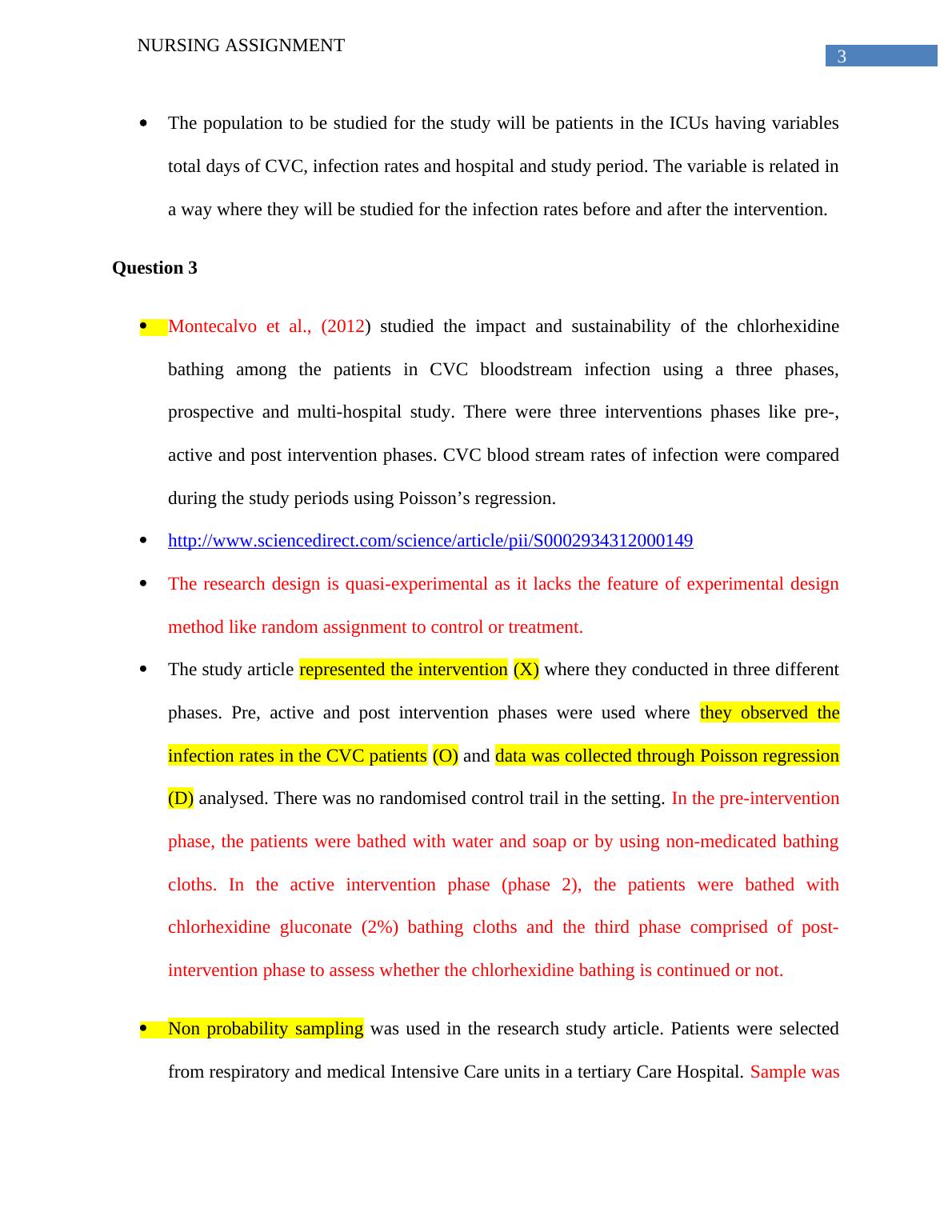NSB236 - Nursing Assignment | Family Nurse
Added on 2020-03-01
13 Pages3182 Words64 Views
Running head: NURSING ASSIGNMENT Nursing assignmentName of the StudentName of the UniversityAuthor note

1NURSING ASSIGNMENT Question 1 According to Fenstermacher & Hudson, (2015) under the practice guidelines for FamilyNurse Practitioners (FNP) program, chlorhexidine dressings are important for the wounddressing. The antiseptics that have a broad spectrum of antimicrobial action help toreduce the healthcare-associated infections. It has a high cellular targets and dailybathing with chlorhexidine reduce the central-line associated BSIs in patients staying inmedical intensive care units. It is not only beneficial in reducing the incidence ofinfections, but also these reduction rates are sustained as performed by FNPs. It is one ofthe best practices that help to reduce the incidence of central line venous infections andwell tolerated by patients. This topic is important for the FNP program as central line venous catheters (CVCs) careis important for the critically ill and hospitalized patients for the nurses to draw blood forsampling, medication infusion and hemodynamic measurement. They are the leadingcause for the healthcare-associated bloodstream infections (BSIs) that are implicated intolife-threatening illnesses. It is important for the nurses as thousands of BSIs occur everyyear contributing to the burden of disease. This is the reason, it is important for thenursing program to use chlorhexidine solution for bathing that reduces the BSIs in thepatients receiving intravenous medications. PICOT question- Does in adult of high complexity settings; the use of antisepticchlorhexidine dressing is effective and has the potential to prevent the potentialcentral venous catheterization (CVC) infections? Nurses and healthcare professionalsprovide chlorhexidine bathing to CVC patients to reduce the central venous infectionsreceiving intravenous medications.

2NURSING ASSIGNMENT Question 2Quantitative approach is the best approach for the Evidence-based project (EBP)proposal. This approach provides information in numerical form through open and closedended questions in structured and unstructured interviews. Quantitative data is easy toanalyse and highly standardized (Lampard & Pole 2015). It is best for the comparison ofdata in a systematic way where it tests the theories with the help of hypothesis. It is usefulfor the generalization of population and compares the information in an extensive manner(Bowling, 2014). It can be used within a specific targeted population to illuminatemeanings associated with the differences. The questionnaires and surveys can be used forexploring the use of chlorhexidine bathing in CVC line patients in reducing infections. PICOT question- In critically ill patients (P), does use of chlorhexidine bathing (I), as compared tothose who do not have chlorhexidine bathing (C), aid in reducing CVC line infections (O)in 6 months (T)? Questions for the survey1.What is the frequency of chlorhexidine bed-bath in CVC patients?2.What is the duration of time bed-bath in CVC patients?3.What cleansing agents are used for the bed-bath?4.At what time patients are given bed-bath in ICU? 5.What are the factors like organizational and patient illness have an impact onbed-bath in the ICUs?

3NURSING ASSIGNMENT The population to be studied for the study will be patients in the ICUs having variablestotal days of CVC, infection rates and hospital and study period. The variable is related ina way where they will be studied for the infection rates before and after the intervention. Question 3Montecalvo et al., (2012) studied the impact and sustainability of the chlorhexidinebathing among the patients in CVC bloodstream infection using a three phases,prospective and multi-hospital study. There were three interventions phases like pre-,active and post intervention phases. CVC blood stream rates of infection were comparedduring the study periods using Poisson’s regression. http://www.sciencedirect.com/science/article/pii/S0002934312000149The research design is quasi-experimental as it lacks the feature of experimental designmethod like random assignment to control or treatment. The study article represented the intervention(X) where they conducted in three differentphases. Pre, active and post intervention phases were used where they observed theinfection rates in the CVC patients(O) and data was collected through Poisson regression(D) analysed. There was no randomised control trail in the setting. In the pre-interventionphase, the patients were bathed with water and soap or by using non-medicated bathingcloths. In the active intervention phase (phase 2), the patients were bathed withchlorhexidine gluconate (2%) bathing cloths and the third phase comprised of post-intervention phase to assess whether the chlorhexidine bathing is continued or not. Non probability sampling was used in the research study article. Patients were selectedfrom respiratory and medical Intensive Care units in a tertiary Care Hospital. Sample was

End of preview
Want to access all the pages? Upload your documents or become a member.
Related Documents
NURSING AND HEALTHCARE ASSIGNMENT.lg...
|6
|1467
|33
Chlorhexidine Dressing Vs Standardised Dressings Evidence Based Practicelg...
|9
|2151
|128
Nursing Assignment Case Studylg...
|9
|2423
|65
Infection Control: The Efficacy of Daily Chlorhexidine Bathing for Preventing Healthcare-Associated Infectionslg...
|3
|1007
|217
Preventive Strategies for Lowering Catheter Associated UTI Riskslg...
|7
|1808
|20
Quantitative Research Methodology Assignmentlg...
|3
|770
|183
